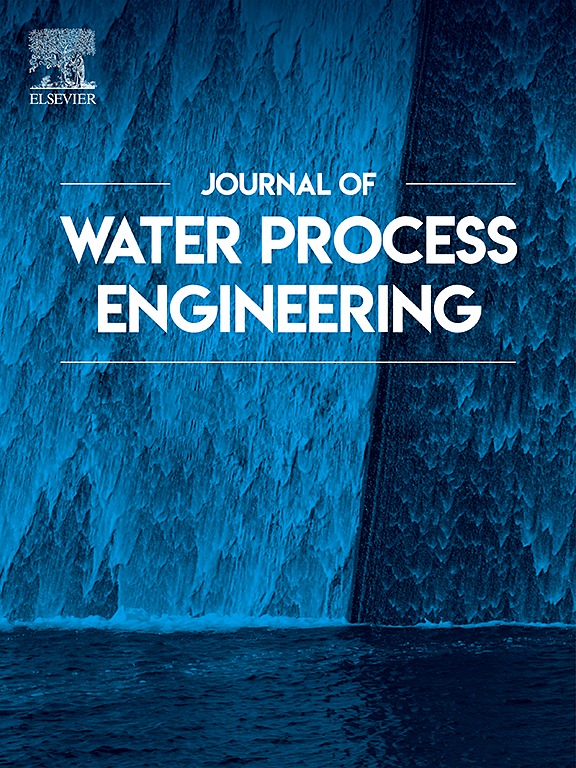利用机器学习探索生物炭对四环素的吸附位点及机理
IF 6.3
2区 工程技术
Q1 ENGINEERING, CHEMICAL
引用次数: 0
摘要
过去,对吸附剂对吸附物的吸附部位和机理的探索主要依靠吸附实验和物理化学表征。机器学习等人工智能技术的出现,为研究吸附位点和机理提供了新的途径。然而,目前大多数利用机器学习研究材料的吸附性能和机理的研究并没有完全提取或揭示化学键和化学状态在吸附过程中的作用和贡献。本研究通过提取和分离材料XPS分析数据,探索性地应用机器学习方法预测和研究生物炭对抗生素的吸附位点和机理。具体来说,本工作采用了4个机器学习模型,分析了关键官能团(包括N-6、π -π和C-O / C-N)与吸附能力之间的相关性。结果表明,N-6、π -π和C-O / C-N结构是促进吸附的关键官能团。其中,π -π相互作用的影响最为显著,表明该机制可能在吸附过程中起主导作用。这种方法不仅有助于识别增强吸附的官能团,而且还将它们与特定机制联系起来,为合理设计生物炭基吸附剂提供了有价值的见解。本文章由计算机程序翻译,如有差异,请以英文原文为准。
Exploring the adsorption sites and mechanism of biochar towards tetracycline using machine learning
In the past, exploration of the adsorption sites and mechanism of adsorbent towards adsorbate largely rely on adsorption experiments and physico-chemical characterization. The emergence of artificial intelligence techniques, such as machine learning, has provided new approaches for studying adsorption sites and mechanisms. However, most current studies using machine learning to investigate the adsorption performance and mechanisms of materials have not thoroughly extracted or revealed the role and contribution of chemical bonds and chemical states in the adsorption process. In this study, by extracting and separating material XPS analysis data, we exploratively apply machine learning methods to predict and investigate the adsorption sites and mechanisms of antibiotic adsorption on biochar. Specifically, this work employed 4 machine learning models for over 344 datasets to analysis the correlations between the key functional groups (including N–6, π–π and C–O/C–N) and adsorption ability. The results showed N–6, π–π and C–O/C–N structures are key functional groups contributing to adsorption. Among them, π–π interaction have the most pronounced effect, suggesting that this mechanism may play a dominant role in adsorption process. This approach not only helps to identify functional groups that enhance adsorption but also links them to specific mechanisms, offering valuable insights for the rational design of biochar-based adsorbents.
求助全文
通过发布文献求助,成功后即可免费获取论文全文。
去求助
来源期刊

Journal of water process engineering
Biochemistry, Genetics and Molecular Biology-Biotechnology
CiteScore
10.70
自引率
8.60%
发文量
846
审稿时长
24 days
期刊介绍:
The Journal of Water Process Engineering aims to publish refereed, high-quality research papers with significant novelty and impact in all areas of the engineering of water and wastewater processing . Papers on advanced and novel treatment processes and technologies are particularly welcome. The Journal considers papers in areas such as nanotechnology and biotechnology applications in water, novel oxidation and separation processes, membrane processes (except those for desalination) , catalytic processes for the removal of water contaminants, sustainable processes, water reuse and recycling, water use and wastewater minimization, integrated/hybrid technology, process modeling of water treatment and novel treatment processes. Submissions on the subject of adsorbents, including standard measurements of adsorption kinetics and equilibrium will only be considered if there is a genuine case for novelty and contribution, for example highly novel, sustainable adsorbents and their use: papers on activated carbon-type materials derived from natural matter, or surfactant-modified clays and related minerals, would not fulfil this criterion. The Journal particularly welcomes contributions involving environmentally, economically and socially sustainable technology for water treatment, including those which are energy-efficient, with minimal or no chemical consumption, and capable of water recycling and reuse that minimizes the direct disposal of wastewater to the aquatic environment. Papers that describe novel ideas for solving issues related to water quality and availability are also welcome, as are those that show the transfer of techniques from other disciplines. The Journal will consider papers dealing with processes for various water matrices including drinking water (except desalination), domestic, urban and industrial wastewaters, in addition to their residues. It is expected that the journal will be of particular relevance to chemical and process engineers working in the field. The Journal welcomes Full Text papers, Short Communications, State-of-the-Art Reviews and Letters to Editors and Case Studies
 求助内容:
求助内容: 应助结果提醒方式:
应助结果提醒方式:


